Create a Tile Palette
Place a selection of Tiles onto Tile Palettes so that you can pick Tiles from the Palette to paint on TilemapsA GameObject that allows you to quickly create 2D levels using tiles and a grid overlay. More info
See in Glossary.
Prerequisites
To create a tilemap you must first ensure you have done the following:
- Download the 2D Tilemap Editor package from the Package Manager.
Create the tile palette asset
To create the tile palette asset, do the the following:
To create a Tile Palette, open the Tile Palette window by going to Window > 2D > Tile Palette.
-
Select the New Palette drop-down menu to open a list of Tile Palettes available in the Project, or for the option to create a new Palette. Select the Create New Palette option to create a new Palette.
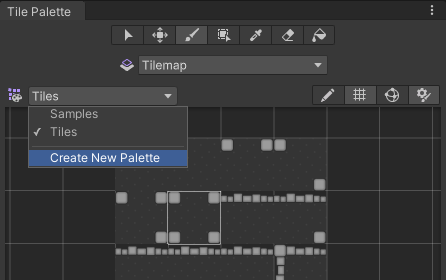
Select the Create New Palette option from the dropdown menu. -
After selecting the option to create a new Tile Palette, the Create New Palette dialog box becomes available. It contains the different property settings and options available when creating a new Palette. Name the newly created Palette and select the desired settings, then select the Create button. Select the folder to save the Palette Asset file into when prompted. The newly created Palette is automatically loaded in the Tile Palette window.
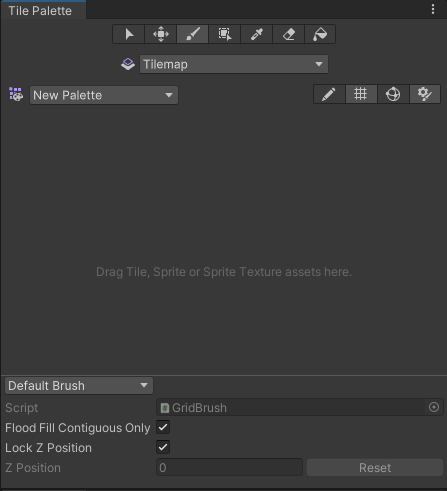
A blank Tile Palette -
Drag and drop Textures or SpritesA 2D graphic objects. If you are used to working in 3D, Sprites are essentially just standard textures but there are special techniques for combining and managing sprite textures for efficiency and convenience during development. More info
See in Glossary from the Assets folder onto the Tile Palette, and choose where to save the new Tile Assets when prompted. New Tile Assets are generated in the selected save location, and the Tiles are placed on the grid of the active Tile Palette window.
Drag and drop directly onto the Tile Palette window. Use inspectorA Unity window that displays information about the currently selected GameObject, asset or project settings, allowing you to inspect and edit the values. More info
See in Glossary to change the current active Brush and its properties. For more information on these properties, refer to the Brush Inspector window reference.
Editing the Tile Palette
The tools for picking and painting with Tiles can also be used to edit the Tile Palette directly, allowing you to move and manipulate the Tiles currently placed on the Tile Palette. Select the Palette you want to edit from the Palette dropdown menu (the default Palette is named ‘New Palette’), then select Edit to unlock the Palette for editing.
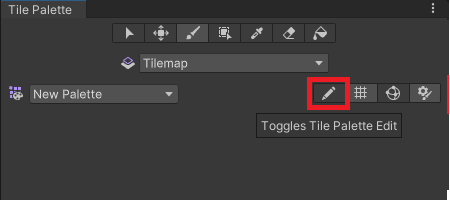
The Tile Palette Edit toggle.
Refer to Tile Palette editor reference for the shortcuts and functions of the Palette tools, which can also be used to edit the Palette.
Creating Palette Assets from existing Grid Prefabs
You can convert an existing PrefabAn asset type that allows you to store a GameObject complete with components and properties. The prefab acts as a template from which you can create new object instances in the scene. More info
See in Glossary to a Palette Asset, so that you can use it in the Tile Palette window. To do this, the Prefab must not already be a Palette Asset, and it must have a Grid component on its topmost GameObjectThe fundamental object in Unity scenes, which can represent characters, props, scenery, cameras, waypoints, and more. A GameObject’s functionality is defined by the Components attached to it. More info
See in Glossary.
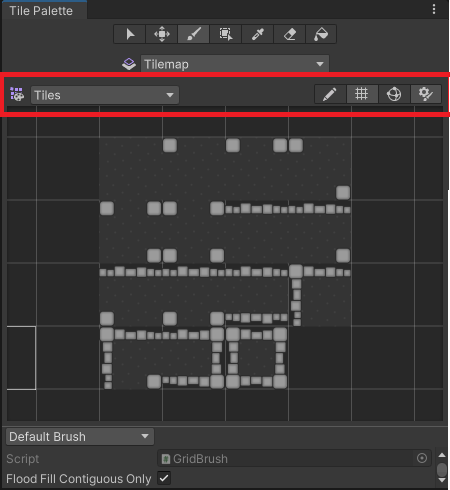
The Tile Palette toolbar
To convert a Prefab, drag and drop it onto the Tile Palette toolbarA row of buttons and basic controls at the top of the Unity Editor that allows you to interact with the Editor in various ways (e.g. scaling, translation). More info
See in Glossary (highlighted in the image above). The Editor automatically converts it to a Palette Asset, and adds a Grid Palette Asset. The new Palette Asset has the same name as its source, and it becomes available in the Palette dropdown menu.
Tile Palette Grid visibility toggle

The Tile Palette Grid toggle.
Switch the visibility of the Grid on the Tile Palette on or off by selecting the toggle highlighted above.
Tile Palette Gizmos visibility toggle
The Tile Palette can display GizmosA graphic overlay associated with a GameObject in a Scene, and displayed in the Scene View. Built-in scene tools such as the move tool are Gizmos, and you can create custom Gizmos using textures or scripting. Some Gizmos are only drawn when the GameObject is selected, while other Gizmos are drawn by the Editor regardless of which GameObjects are selected. More info
See in Glossary over the currently selected Palette Asset, to help you visualize specific criteria. For example, you can add a Gizmo that displays a special icon for Tiles that contain no Sprites.
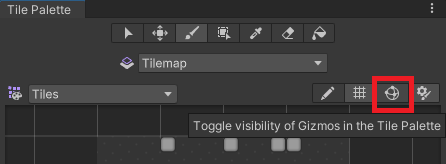
The Tile Palette Gizmos toggle.
To display the default Unity and the Palette Asset’s Gizmos on the Tile Palette, enable the Gizmos toggle (highlighted above). The Tile Palette immediately displays any component with MonoBehaviour.OnDrawGizmos() in the Palette Asset.
To add your own custom gizmos to a Palette Asset, add a component with DrawGizmo to the Palette Asset:
- Select the Palette Asset in the Project windowA window that shows the contents of your
Assetsfolder (Project tab) More info
See in Glossary. - Open the Palette Asset in Prefab Mode.
- Add the component while in Prefab Mode.
- Save the Asset while in Prefab Mode.
- Exit Prefab Mode.